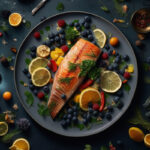If you’re a fan of Korean cuisine or want to experiment with new flavors, Korean cookbooks are an excellent resource to turn to for inspiration. With so many to choose from, it can be overwhelming to know where to start. In this article, we’ll explore the best Korean cookbooks for delicious home-cooked meals, covering traditional recipes, beginner-friendly options, and modern fusion dishes.

The Rich History of Korean Cuisine
Korean cuisine has a long and complex history, influenced by centuries of invasion, migration, and trade. Early Korean food centered around rice, vegetables, and meats, with a strong emphasis on fermentation to preserve food. Over time, new ingredients and cooking techniques were introduced, leading to the diverse range of flavors and textures that we know today.
The history of Korean cuisine is closely tied to the country’s geography and climate. Korea is a peninsula with a long coastline, so seafood has always been a significant part of the diet. The country also has a varied landscape, with mountains, forests, and plains, which have led to the cultivation of different crops in different regions.
Traditional Korean Ingredients and Techniques
One of the essential qualities of Korean cooking is its reliance on fresh, seasonal ingredients. Staples like soy sauce, sesame oil, and chili powder are used in many dishes, creating layers of complex flavors. Fermentation also plays a significant role, with kimchi, doenjang, and gochujang featuring prominently in many traditional Korean dishes.
Kimchi, in particular, is a staple in Korean cuisine and is a type of fermented vegetable dish. It is made by salting and then fermenting vegetables, usually cabbage, with spices and seasonings. Kimchi is served as a side dish with almost every meal in Korea and is also used as an ingredient in many other dishes.
Cooking techniques in Korean cuisine also vary widely, from boiling and grilling to stir-frying and steaming. The use of clay pots and bamboo steamers are common, adding a unique depth of flavor and texture to dishes. For example, bibimbap, a popular Korean dish, is served in a hot stone bowl, which gives the rice a crispy texture.
The Influence of Regional Flavors
The regional variation in Korean cuisine is also worth noting. Each province in Korea has its own unique dishes and ingredients, with some regions famous for their spicy flavors, while others focus more on seafood or vegetable-based dishes.
Jeju Island, located off the southern coast of Korea, is known for its seafood, including abalone, sea urchin, and octopus. The province of Gyeongsang, on the southeastern coast, is famous for its spicy cuisine, including dishes like bulgogi and galbi. And the capital city of Seoul is known for its street food, including tteokbokki, a spicy rice cake dish, and hotteok, a sweet pancake filled with brown sugar and nuts.
In conclusion, Korean cuisine is a rich and diverse culinary tradition that has evolved over centuries. From its humble beginnings as a simple rice and vegetable-based diet, it has grown to incorporate a wide variety of ingredients and cooking techniques, making it one of the most exciting and flavorful cuisines in the world.
Top Korean Cookbooks for Beginners
If you’re new to Korean cooking, it can be challenging to know where to start. Korean cuisine is known for its bold flavors and unique ingredients, which can be intimidating to those who have never cooked with them before. However, with the right guidance, anyone can learn to make delicious Korean dishes at home. Here are three excellent Korean cookbooks that are perfect for beginners:
“Korean Cooking Made Simple” by Julie Yoon
With easy-to-follow recipes and clear instructions, “Korean Cooking Made Simple” is an excellent choice for anyone new to Korean cuisine. The book covers a broad range of dishes, from classic comfort food to modern fusion dishes. Julie Yoon, a Korean-American chef and food blogger, wrote this cookbook to help demystify Korean cooking for home cooks. Her recipes are approachable and use ingredients that are easy to find in most grocery stores. She also includes helpful tips and tricks for mastering Korean cooking techniques, such as making perfect rice and fermenting kimchi.
“Korean Food Made Easy” by Caroline Hwang
Another beginner-friendly cookbook, “Korean Food Made Easy,” includes over 60 simple and delicious recipes, each accompanied by detailed photographs. The book is perfect for those who want to experiment with Korean flavors but don’t have a lot of experience in the kitchen. Caroline Hwang, a Korean-American food writer and recipe developer, created this cookbook to showcase the diversity of Korean cuisine. Her recipes range from classic dishes like bibimbap and bulgogi to lesser-known gems like acorn jelly and spicy fish stew. She also includes a helpful glossary of Korean ingredients and cooking terms to help readers navigate the world of Korean cooking.
“Cook Korean!” by Robin Ha
“Cook Korean!” is a fun and colorful cookbook perfect for those who want to learn about Korean culture alongside their cooking. The book includes over 80 traditional Korean recipes, each accompanied by a charming illustration and detailed instructions. Robin Ha, a Korean-American cartoonist and food blogger, wrote and illustrated this cookbook to share her love of Korean food and culture with a wider audience. Her recipes are easy to follow and include helpful tips for making each dish look as beautiful as it is delicious. She also includes fun facts and stories about Korean food and culture throughout the book, making it an enjoyable read as well as a useful cookbook.
Best Korean Cookbooks for Traditional Recipes
If you’re a foodie, you know that Korean cuisine has been gaining popularity in recent years. From kimchi to bulgogi, Korean food is known for its bold flavors and unique ingredients. If you’re interested in exploring classic Korean dishes, these three cookbooks are fantastic resources:
“Maangchi’s Real Korean Cooking” by Maangchi
Maangchi is a YouTube sensation famous for her approachable and authentic Korean recipes. Her cookbook, “Maangchi’s Real Korean Cooking,” includes over 100 traditional Korean dishes, each with detailed step-by-step instructions. The book also features beautiful photographs of the finished dishes, making it easy to see how your own creations should look. Maangchi’s passion for Korean food is infectious, and her cookbook is a must-have for anyone interested in learning more about Korean cuisine.
“Korean Home Cooking” by Sohui Kim
“Korean Home Cooking” is a fantastic cookbook for anyone looking to recreate traditional Korean dishes at home. The book includes over 100 recipes, covering everything from classic soups and stews to noodle dishes and vegetable side dishes. Sohui Kim, the author, is a Korean-American chef and restaurateur who grew up cooking with her mother and grandmother. Her cookbook is filled with personal stories and family recipes, making it feel like you’re cooking with a friend. The book also includes a section on Korean pantry staples, so you can stock up on all the ingredients you’ll need to make the recipes.
“The Korean Table” by Taekyung Chung and Debra Samuels
“The Korean Table” showcases the diversity of regional Korean cuisine, with recipes from some of Korea’s most famous chefs. The book includes traditional dishes like bibimbap and Korean fried chicken, alongside lesser-known regional specialties. The authors, Taekyung Chung and Debra Samuels, provide background information on each dish, including its history and cultural significance. The book also includes a section on Korean table settings and etiquette, so you can learn how to properly serve and enjoy a Korean meal.
Whether you’re a seasoned cook or a beginner in the kitchen, these three Korean cookbooks are great resources for exploring the world of Korean cuisine. With their detailed instructions, beautiful photographs, and personal stories, they’ll inspire you to try new recipes and expand your culinary horizons.
Korean Cookbooks for Modern and Fusion Recipes
Are you a fan of Korean cuisine? Do you love to experiment with new flavors and techniques in the kitchen? If so, then these cookbooks are perfect for you!
Korean cuisine is known for its bold and complex flavors, and these cookbooks take traditional Korean ingredients and flavors to a whole new level. Whether you’re looking for modern twists on classic dishes or fusion recipes that blend Korean and other cuisines, these cookbooks have something for everyone.
“Korean Fusion Food” by Judy Joo
Chef Judy Joo is a master at combining traditional Korean ingredients and flavors with modern cooking techniques. In her beautiful cookbook, “Korean Fusion Food,” she shares her favorite recipes for dishes like bulgogi beef sliders and kimchi mac and cheese. These dishes are perfect for anyone looking for a new twist on familiar flavors.
But this cookbook is more than just a collection of recipes. Chef Joo also shares her personal story, including her journey from a career in finance to becoming a chef, and her experiences as a Korean-American woman in the food industry. Her passion for Korean cuisine and her unique perspective make this cookbook a must-read for any food lover.
“Korean-American Cooking for Today’s Home Cook” by Hooni Kim
Chef Hooni Kim’s cookbook, “Korean-American Cooking for Today’s Home Cook,” is a treasure trove of delicious Korean-American fusion dishes. With over 90 recipes, this cookbook is perfect for anyone looking to experiment with new flavors and techniques in the kitchen.
From Korean-style fried chicken to kimchi quesadillas, Chef Kim’s recipes are creative, flavorful, and easy to make at home. But this cookbook is more than just a collection of recipes. Chef Kim also shares his personal story, including his journey from a career in finance to becoming a chef, and his experiences as a Korean-American in the food industry. His passion for Korean cuisine and his unique perspective make this cookbook a must-read for any food lover.
“Korean BBQ: Master Your Grill in Seven Sauces” by Bill Kim
If you love Korean barbecue, then “Korean BBQ: Master Your Grill in Seven Sauces” by Chef Bill Kim is a must-have cookbook. Chef Kim shares his secrets for grilling perfect Korean meats and vegetables, accompanied by his signature sauces and marinades.
From classic bulgogi to spicy pork belly, Chef Kim’s recipes are sure to impress your family and friends at your next barbecue. But this cookbook is more than just a collection of recipes. Chef Kim also shares his personal story, including his journey from a career in fine dining to opening his own Korean barbecue restaurant, and his experiences as a Korean-American in the food industry. His passion for Korean cuisine and his unique perspective make this cookbook a must-read for any food lover.
So what are you waiting for? Get your hands on these cookbooks and start cooking up some delicious Korean-inspired dishes today!
The Final Word
Whether you’re a beginner cook or a seasoned pro, these Korean cookbooks are an excellent resource for anyone looking to explore the rich and diverse world of Korean cuisine. From traditional recipes to modern fusion dishes, there’s something for everyone in these fantastic cookbooks. Happy cooking!
FAQs
What are the most popular Korean dishes?
In South Korea, foods such as kimchi, bulgogi, rice cakes, jajangmyeon, bao buns, bibimbap, and samgyeopsal are all very popular.
What do Koreans eat daily?
Traditional meals are usually served with rice, kimchi, and vegetables, but meats and seafood are also regularly eaten.
What are the easiest Korean meals to make?
Kimchi stew, sticky chicken drumsticks, and jogaetang (seafood broth) are all easy, quick, and tasty meals originating from Korea.
What is kimchi?
Kimchi is a popular Korean dish that typically consists of fermented and salted vegetables, usually cabbage or radish.
- The 11 Best Books About Cats You Should Read - January 16, 2024
- The 9 Best Books on Building Confidence - January 16, 2024
- Discover the 10 Best Books on the Brain - January 16, 2024


